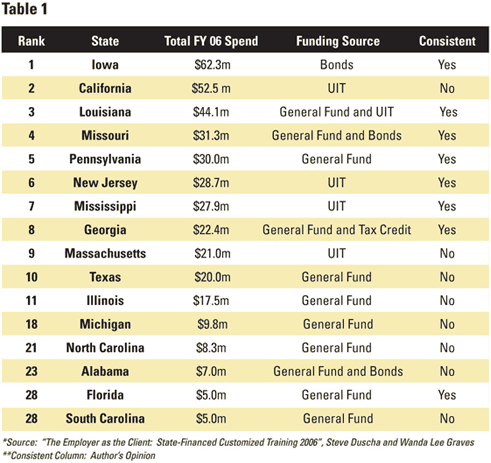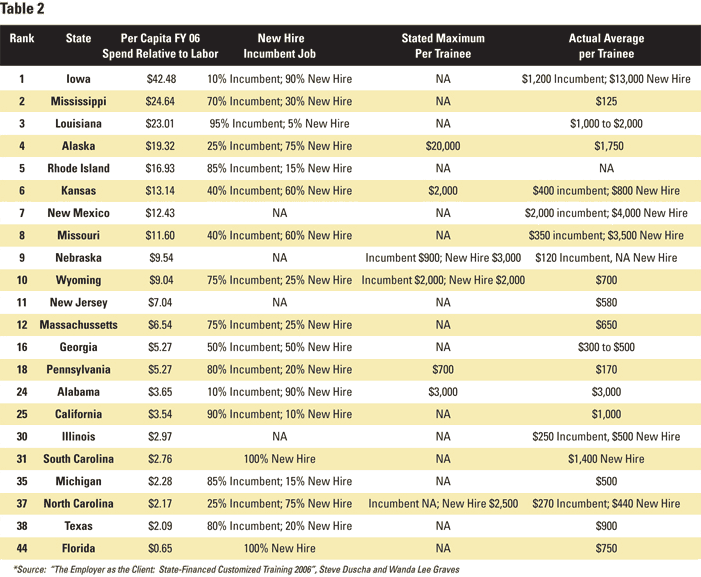ork-force training programs are designed to either support new job creation or increase the skill level of the incumbent workforce. Work-force training monies flow through reimbursable programs or tax credit programs funded by various sources including: Unemployment Insurance Taxes (“UIT”), General Fund Appropriations, Future Payroll Taxes, or Income and Franchise taxes.
Generally, to secure reimbursable monies, the taxpayer must estimate future training needs and then reconcile actual to estimated training on a monthly basis. To secure tax credits, the taxpayer calculates the benefit based on actual training conducted over the previous year and files on the appropriate tax return.
Regardless, in determining a program’s actual value, a taxpayer should consider the following factors:
Funding Source;
Program Limitations; and
Program Bureaucracy.

Table 1 shows states ranked by their training budgets, followed by their funding source. The last column notes whether the budgets over the past decade have been consistent.
Overall, programs funded through general funds have a more inconsistent track record than self-funded programs such as tax credits or payroll tax bonds. Through the general fund appropriation process, training programs are often subject to budget cuts and/or re-appropriation of funds due to current state priorities. Also, with programs sourced through general funds, there is typically an application schedule where monies are more readily available at the beginning of the states’ fiscal year than the end of the year. Therefore, timing of available monies may not always suit a company’s training needs.
Work-force training programs are limited by criteria such as: industry type, caps per trainee/course/company, new hire versus incumbent training, and a private sector percentage training match. As such, although many states market their work-force development programs through a maximum-amount-per-trainee metric, program mechanics often yield a much lower result.
The following table notes states ranked by their per capita training spend relative to the labor force, followed by their stated maximum available per trainee, percent of funds targeted to new hire and incumbent training, and their actual average training per employee.
Evident from Table 2, states that spend on both incumbent and new-hire training invest far more dollars in new-hire training than support for the existing work force. Also, some states, particularly in the Southeast, focus predominantly on new-hire training. Per Steve Duscha and Wanda Lee Graves, the actual reimbursement on a national basis in 2006 was $525 per trainee.

Work-force programs are administered through various agencies including economic development departments, community colleges and work-force agencies such as Work-force Investment Boards. It is not unusual for several training agencies to “touch” the project, making it necessary to “flow chart” the process to stay on track.
Couple the process to secure benefits with the pressure for training agencies to keep the monies to a minimum or an average, and it is easy to understand how training benefits can become paper- and process-intensive relative to their potential size.
Instead of listing the most bureaucratic programs – you know who you are – following are examples of two states that have gotten it right:
ETP is the primary discretionary economic development tool in California. Although program funding has been inconsistent, ETP continues to work in a proactive and collaborative way with its clients to maximize use of its funds. ETP, through its budget struggles, continues to support California’s existing work force.
The ETP process follows:
Electronic Preliminary Application;
Project assignment to a Regional Office;
Regional Office Site Visit;
ETP Application Filing and presentation to ETP Panel; and
If approved, ETP Agreement Execution.
*Source: Employment Training Panel Annual Report, FY 2005-2006
Although the process is known to be cumbersome and not always user friendly, ETP has recently created additional flexibility through training hour calculations that makes program compliance more efficient. ETP personnel are very professional and step through each part of the process with the client.
RTC is the primary training tool in Georgia. As with California, Georgia supports its existing work force in equal measure to new jobs. An income tax credit is provided for eligible retraining expenses that enhance the functional skills of employees who otherwise would be unable to function effectively on the job. Tax credits may be granted up to 50 percent of the direct cost of retraining up to $500 per trainee per approved training program.
The RTC process follows:
Submit RTC Approval Form to the Local Technical College, Economic Development Representative (“Tech”);
Tech reviews for eligibility, adequacy and completeness;
Submit RTC Completion Form to Tech for approval; and
Attach the Completion Form with Form IT-RC along with the tax return.
*Source: Georgia Retraining Tax Credit Guide
Although the process is calculation- and paper-intensive, the tax credit process is effective at supporting eligible training. Through a tax credit, the client can focus on actual training activities rather than spending an inordinate amount of time estimating future training and having to reconcile estimated to actual on a monthly basis. RTC personnel are also very professional and they have a great understanding of how business actually works.
Taxadvantagegroup (“tag”) llc maintains a database of federal and state incentive programs, IncentivePro. To date, the database documents over 3,200 incentive programs, over 200 of which subsidize work-force training. Because the programs are so varied, following are the macro steps taken by tag when evaluating a particular program:
Prior to beginning a project, read about each program in their most recent Annual Report to determine actual outcomes.
It may take a sizable training curriculum to justify the administrative costs of working through a program. Regardless of the maximum benefits available, benchmark each opportunity at the actual average per trainee in order to set reasonable expectations. If an average per incumbent trainee is not available, use one-half of the total actual average for all trainees as a benchmark for incumbent workers.
For reimbursable programs, the process can take three to four months, if all internal information is “ready to go,” for program approval.
For reimbursable programs, it is not unusual to run into programmatic or political issues that may cause concern. If the issues seem to outweigh the anticipated benefits, pull the plug and withdraw from the program.
Tammy C. Propst is the President of taxadvantagegroup (“tag”) llc, a real estate and financial advisory firm. Tammy’s experience includes having served as the Partner-in-Charge of KPMG’s Business Incentives Group.